When it comes to beautiful cats, the grey tabby certainly makes the list. Cat lovers worldwide appreciate these gorgeous kitties for their stunning patterns and smoky to silver fur.
But did you know?
The grey tabby is not a specific breed of cat but is a common striped coat pattern that is found in purebred and mixed (random bred) cats.
Cats have six basic coat patterns [1]:
- Solid
- tabby
- bi-color
- pointed
- tortoiseshell and
- tricolor.
The tabby pattern is thought to have come from the African wildcat (Felis lybica) and consists of two components.
- Background: Alternating agouti hairs are made up of bands of black and yellow (brown tabbies) or black and off-white (grey tabbies).
- Pattern: Melanistic overlay of bars, spots, swirls and rosettes.
The agouti gene (symbolised by an uppercase A) is dominant over its mutant form non-agouti (lowercase a). The cat carries two sets of genes, inherited from the mother and father. If the cat carries a copy of the A gene, it will be tabby, in order for it to be non-tabby (a solid colour, such as black), it must inherit two copies of the recessive ‘a’ gene, one from each parent.
- AA – Tabby
- Aa – Tabby
- aa – Non-tabby
The silver/grey background is caused by an inhibitor gene
The silver is caused by the melanin inhibitor gene I/i, which suppresses the development of pheomelanin (yellow pigment) from the agouti areas of the coat. Normally, the background colour has areas of yellow and black banding (ticking) along the hair shaft. The absence of yellow makes the black tabby pattern stand out against the pale background.
Occasionally, the yellow colour can be seen in parts of the coat, known as tarnishing. Breeders have worked hard to eliminate this by selective breeding, and tarnishing is most frequently seen in random-bred cats.
There are four grey tabby patterns
The coat pattern of the grey tabby occurs in three patterns, mackerel, classic, spotted and ticked.
Mackerel tabby: Also known as ‘tiger cats‘, the mackerel is the original wild-type pattern and consists of a dark stripe along the back and a fishbone pattern down the side of the cat. Mackerel tabby is the most common tabby pattern and is dominant, therefore the cat only needs to inherit one copy of the Tm gene to be mackerel tabby.
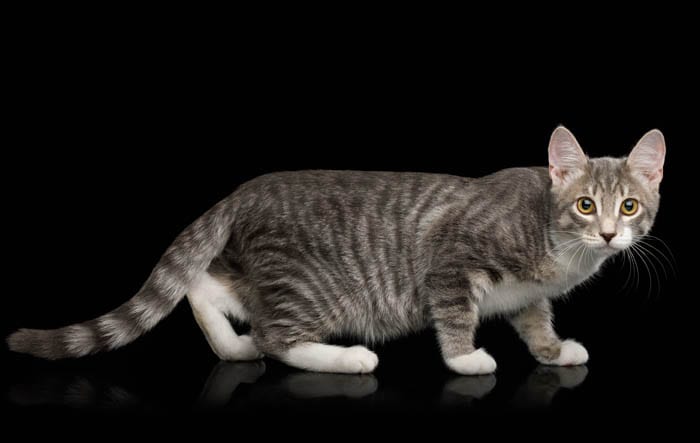
Classic tabby: Also known as blotched or marbled, the classic tabby pattern is recessive to mackerel, which means the cat must inherit a copy of the classic tabby gene from each parent to have the pattern. Grey classic tabby coats consist of a silver background with sworls of dark and a circular bullseye on the flanks. The classic tabby pattern first emerged in the middle ages.
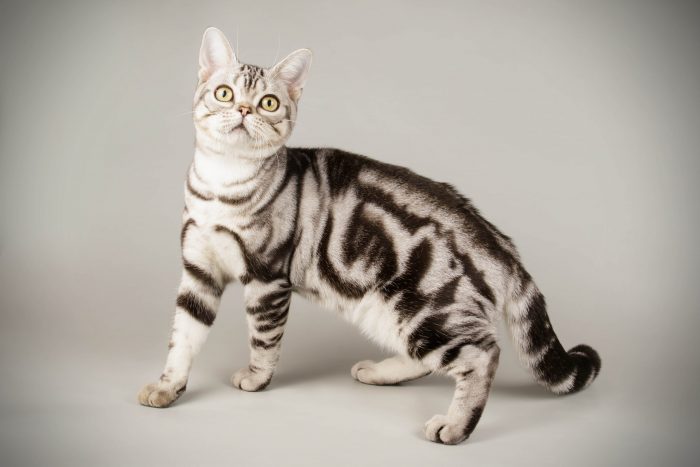
Spotted: The spotted grey tabby is a variant of the mackerel tabby however a modifier gene breaks the characteristic mackerel stripes up into spots.
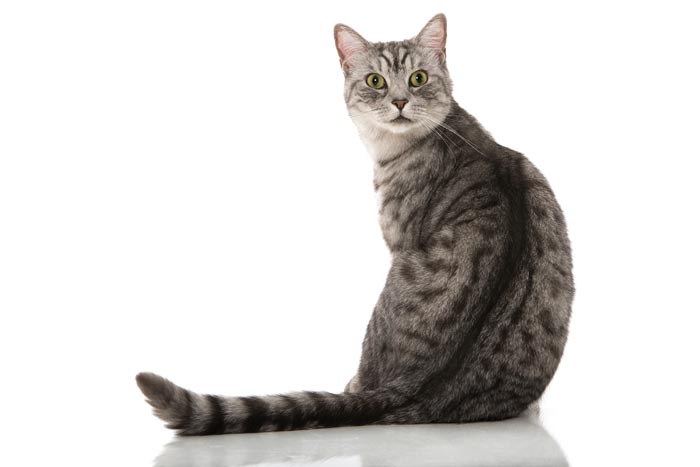
Ticked: Also known as agouti tabby, the ticked tabby cats have a gene that hides the tabby striping, leaving only the underlying agouti colouration. Each hair has bands of colour along the hair shaft. There is little to no striping on the body, but some faint fine barring may be present on the face, legs and tail, this may be more apparent if the cat is heterozygous, meaning its genetic makeup is Ta/Tm or Ta/tb
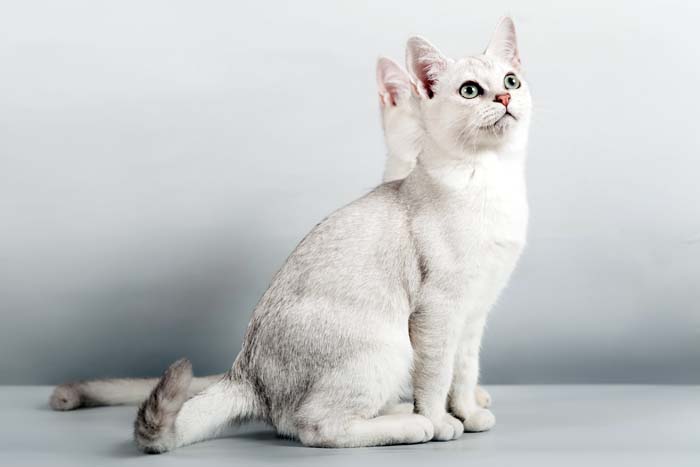
Grey tabby cat eye colours
All grey tabby cats are born with blue eyes, this gradually changes during the first few weeks of life. Older kittens and adult grey tabbies can have eye colours that range from pale gold to deep green.
Grey tabby personality
The personality of a grey tabby cat can vary depending on the breed as well as early experiences as a kitten. Kittens who have a lot of positive human interaction from an early age are more likely to grow into happy and well-adjusted adults.
Grey tabbies in purebreds and random-bred cats
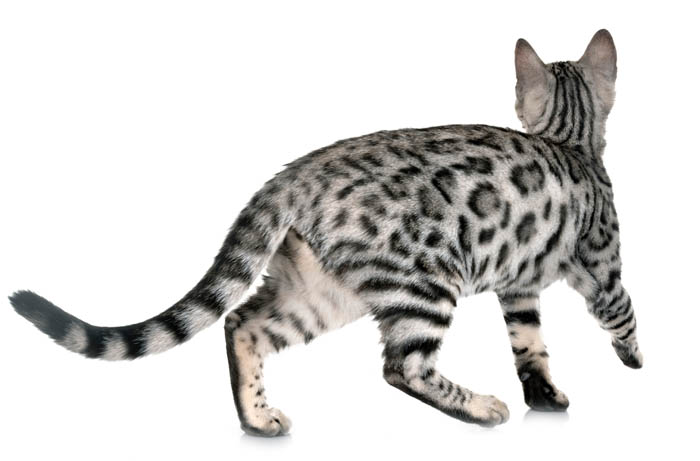
The default ‘wild type’ pattern is the brown tabby, but the grey tabby coat colour is present in both random-bred as well as different breeds of cat. Although all coat colours and patterns are permitted, the American Shorthair is most well known for its grey classic tabby coat, the Ocicat for its spotted coat and Bengal for its marbled or spotted/rosette pattern. Other breeds which can have the grey tabby pattern include the Munchkin, Scottish Fold, Devon Rex, Cornish Rex, Norwegian Forest cat and Maine Coon. The Siamese or Colourpoint Shorthair may also have the grey tabby pattern as points on the face, legs and tail.
Heath problems in grey tabby cats
Of course, we all want happy and healthy cats.
People often wonder, “Are there specific health problems associated with grey tabby cats that I should be aware of?”
Surprisingly, yes. Although grey tabby cats are not an individual breed, they do come with an array of health conditions and predisposition to diseases that pet owners need to know about. The good news is, when diagnosed early, these health problems are largely treatable.
First, according to the American Society for the Prevention of Cruelty to Animals, tabby cats of all colours and coat patterns (including grey) are prone to hyperthyroidism, vomiting, urinary trouble, upset stomach, and weight issues. The most pressing of these ailments is obesity. Tabby cats love to eat!
How to care for a tabby cat and avoid these unpleasant conditions?
Easy.
Simply take good care of your cat. This means regular veterinarian checkups and bloodwork, high-quality food, adequate exercise, and proper grooming. It’s also recommended that kitty parents limit mealtimes and feed high calorie treats sparingly to stop your grey tabby cat from getting a little too chubby!
Likewise, always offer a grey tabby fresh water 24/7 to minimize the risk of urinary troubles.
Grey tabby cats in history

Harrison Weir, the father of the cat fancy and president of the National Cat Club, talks about the silver (grey) tabby in his book Our Cats and All About Them, dated 1889. He writes:
The ordinary dark tabby the same way as the brown, and so also the blue or silver, only the ground colour should be of a pale, soft, blue colour – not the slightest tint of brown in it. The clearer, the lighter, and brighter the blue the better, bearing in mind always that the bands should be of a jet black, sharply and very clearly defined. [2]
Where does the word tabby come from?
The name tabby comes originates from the seventeenth-century French word tabis, which itself originated from atabi (or attābiyy), a type of silk that was manufactured in Al-ʿAttābiyya, a quarter of Baghdad district which was named after Ummayad Governor of Mecca, Attab ibn Asid. This silk was exported to England and on one occasion its patterns were compared to the markings on what was then known as the striped cat or tiger cat. As a result, these cats soon became known as tabby cats, which was then shortened to tabby.
Harrison Weir goes on to say:
The word tabby is derived from a kind of taffeta, or ribbed silk, which when calendered or what is now termed ‘watered’ is by that process covered with wavy lines. This stuff, in bygone times, was often called “tabby” hence the cat with lines or markings on its fur was called a “tabby” cat. But it might also, one would suppose, with as much justice, be called a taffety cat, unless the calendering of “taffety” caused it to become “tabby”. Certain it is that the word tabby only referred to the markings or stripes, not the absolute colour, for in “Wit and Drollery” (1682), P. 343, is the following:
“Her petticoat of satin,
Her gown of crimson tabby”
The tabby was also known as the brinded cat, the brindled cat, or the tiger cat. [3]
National tabby day
The United States of America celebrates National Tabby Day on 30th April every year.
Frequently asked questions
Are grey tabby cats rare?
The grey tabby cat isn’t as common as the default brown tabby cat, but they are not rare.
What breed are grey (silver) tabby cats?
Grey tabby is a coat colour and pattern, not a breed. Most grey tabby cats are domestic shorthairs or domestic longhairs (which means they are not purebred), but grey tabby is also common in many purebred cats.
The American Shorthair is recognised for its stunning grey tabby coat.
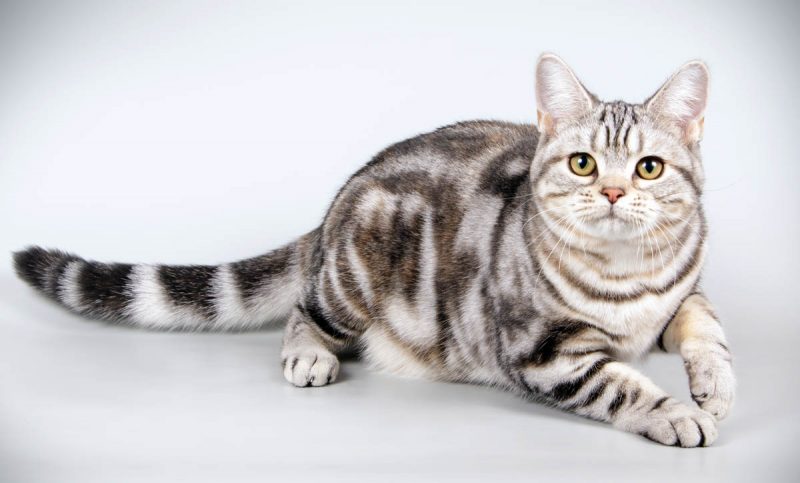
How long do grey tabby cats live?
Most cats, including the grey tabby cat, live for between 12-15 years. Feeding a well-balanced quality cat food as well as regular veterinary visits may contribute to a longer lifespan.
Grey tabbies can have long hair or short hair
The grey tabby cat is most common in shorthaired cats, but can also occur in cats with long coats, especially purebreds.
Meaning behind the M on the tabby’s forehead
All tabbies have an M on their forehead and there are several theories as to how this happened.
- The baby Jesus began to shiver on the night he was born, the virgin Mary wrapped Jesus in blankets, but he continued to cry. She laid him in his manger and he continued to cry. A tabby cat came along, and jumped into the manger and lay beside Jesus, purring loudly and the baby stopped crying. As a sign of gratitude, Mary drew an M on the cat’s forehead. There are different versions of this story, but a common theme is that the cat comforted the baby, after Mary and several farm animals had failed to stop Jesus crying. Interestingly, there is no mention of cats in the bible, so I’m not sure how this story has been shared.
- A snake crawled into the sleeve of Prophet Muhammad’s robe, and a cat quickly killed it. The Prophet affectionately stroked the back of the cat three times giving cats the ability to land on their feet, and placed his hand on the forehead, leaving his initial M as a sign of love for cats.
- Muezza was said to be Prophet Muhammad’s favourite cat, and one day, while preparing for prayer, he found a cat sleeping on the sleeve of his robe. Instead of waking the cat, he used a pair of scissors to cut off the sleeve.
Are grey tabby cats always female?
The grey tabby coat pattern isn’t sex-linked like the orange colour, and a cat only has to inherit one copy of the I (inhibitor) gene and one copy of the A (agouti) from either parent to be a grey tabby.
Are grey tabby cats friendly/good family pets?
Yes! Grey tabby kittens and cats make wonderful feline friends to share your home with. As previously mentioned, their personalities will vary depending upon their upbringing. Early socialization is key to having a well-adjusted cat. But overwhelmingly, these cats are friendly and affectionate with children and adults.
Looking for a cuddler? A grey tabby cat could be the purrrfect fit.
Are tabby cats chatty?
Next, consider your noise tolerance before adopting a grey tabby cat. While they aren’t nearly as vocal as a Siamese, they are more talkative than the average feline breed. These cats meow to communicate. And since grey tabby cats are sociable, they won’t be shy about letting you know when they want attention, petting, and food.
Do tabby cats shed?
They sure do. But how much is the question…
One of the most interesting things about tabby cats is their fur. They can have either long or short hair (with short being more common). Naturally, their shedding volume depends on which type they inherit. The thicker the coat, the more frequently owners should brush them.
Generally speaking, grey tabby cats are moderate shedders.
Are tabby cats hypoallergenic?
No.
Truly hypoallergenic cats produce less of a special protein, called the “Fel d 1 Protein.” Unlike the Sphynx or Russian Blue, grey tabby cats are not a breed of their own. Therefore, they cannot be categorized as hypoallergenic.
Do tabby cats get along with other cats?
Thinking about adding a grey tabby cat to your fur family?
You won’t go wrong with a tabby. Assuming no behaviour issues are present, they make delightful kitty siblings. This is thanks to their cheerful nature, playfulness, and independent streak which allows them to be present, but not insecure or “clingy.”
The only time to be extra careful is if you are adopting a stray. Many shelters will have grey tabby cats. If born on the street, they could lack socialization skills, be fearful, or struggle with aggression. Always be mindful of this when introducing a new animal.
Overall, grey tabby cats make lovely and unique looking pets!
References
[1] Vella, C. M. (1999). Robinson’s genetics for cat breeders and veterinarians. Butterworth-Heinemann.
[2] Weir, H. (1889). Our cats and all about them. Houghton, Mifflin and Company.
[3]Weir, H. (1889). Our cats and all about them. Houghton, Mifflin and Company.
[4] Morris, D. (1997). Cat World. Penguin Group.
